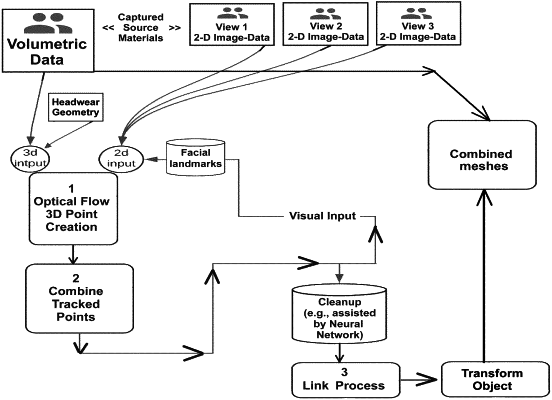| CPC G06V 20/653 (2022.01) [G06F 18/22 (2023.01); G06T 7/20 (2013.01); G06T 13/40 (2013.01); G06T 15/08 (2013.01); G06T 17/10 (2013.01); G06T 17/20 (2013.01); G06T 17/205 (2013.01); G06T 19/20 (2013.01); G06V 10/754 (2022.01); G06V 40/23 (2022.01); G06T 2200/08 (2013.01)] | 20 Claims |

|
1. A method comprising:
(a) receiving a plurality of three-dimensional volumetric datasets that correspond to a particular object;
(b) generating, from said plurality of three-dimensional volumetric datasets, a single uniform mesh dataset that corresponds to said particular object;
wherein a size of said single uniform mesh dataset is less than ¼ of an aggregate size of said plurality of three-dimensional volumetric datasets;
wherein the generating comprises:
adding a virtual differentiator feature into a particular portion of said particular object, which is spatially tracked over time and across frames, to improve correctness of computer-based tracking of said particular object as it is being animated or redressed;
wherein adding the virtual differentiator feature is performed by one or more operations selected from the group consisting of:
(I) adding a particular texture to said particular portion of said particular object,
(II) adding a particular layer said particular portion of said particular object,
(III) adding one or more particular vectors to particular portion of said particular object,
(IV) adding one or more particular data-points to said particular portion of said particular object from a different angle;
wherein the added virtual differentiator feature is used to perform at least one of:
(A) distinguishing among two or more portions of a volumetric dataset;
(B) distinguishing among two or more portions of a three-dimensional representation that corresponds to two or more regions of the particular object that are visually identical to each other;
(C) distinguishing among two or more portions of a three-dimensional representation that corresponds to two or more regions of the particular object that are similar to each other but are not identical to each other;
(D) enabling temporal-coherence uniform topology in applying an animation effect to said particular object;
(E) enabling temporal-coherence uniform topology in applying a texture effect to said particular object.
|